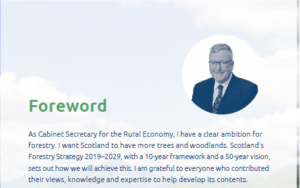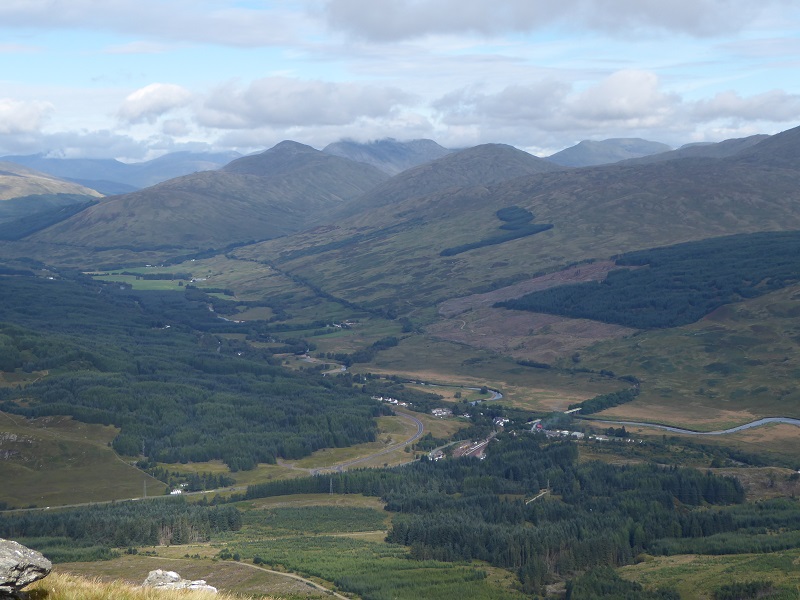 Scotland’s Forest Strategy 2019-29 launched 10 days ago contains not a single reference to National Parks. There is just one reference to Caledonian Forest and that is within a paragraph which describes the range of woodland in Scotland. Nothing is said about the place of the Caledonian Forest in expanding forest cover across Scotland despite Fergus Ewing, the Scottish Government Minister responsible, highlighting this objective before all others (see above). Nor does the strategy give any role to montane scrub, atlantic oak forest or “wild” woods (though it does say a “wildwood” existed 6000 years ago). Like most other Scotland wide strategies concerned with land-use it provides a pick and mix set of principles for decision makers rather than setting specific objectives for specific areas. It contains no acknowledgement that designated areas, such as National Parks, should be managed differently. That is both a missed opportunity and a challenge for our National Parks whose very purpose is to promote conservation, public enjoyment and wise use of resources as well as sustainable development.
Scotland’s Forest Strategy 2019-29 launched 10 days ago contains not a single reference to National Parks. There is just one reference to Caledonian Forest and that is within a paragraph which describes the range of woodland in Scotland. Nothing is said about the place of the Caledonian Forest in expanding forest cover across Scotland despite Fergus Ewing, the Scottish Government Minister responsible, highlighting this objective before all others (see above). Nor does the strategy give any role to montane scrub, atlantic oak forest or “wild” woods (though it does say a “wildwood” existed 6000 years ago). Like most other Scotland wide strategies concerned with land-use it provides a pick and mix set of principles for decision makers rather than setting specific objectives for specific areas. It contains no acknowledgement that designated areas, such as National Parks, should be managed differently. That is both a missed opportunity and a challenge for our National Parks whose very purpose is to promote conservation, public enjoyment and wise use of resources as well as sustainable development.
The Strategy claims that practice over the last thirty years has changed from “industrial, intensive, single purpose” forestry, which focusses on the production of timber, to “sustainable forest management”. Anyone with any knowledge of the Loch Lomond and Trossachs National Park will know that it is still covered with vast swathes of forest plantation. The Scotland Strategy commits to using the UK Forest Standards. While these acknowledge “the landscape impacts of afforestation, clearfelling and forest roads” and state these should be “considered in the context of the
designation(s) and policies that apply” unfortunately, in the Loch Lomond and Trossachs National Park at least, there are no different policies. The result is uniform forest blocks, clearfelling and vast forest roads constructed without any regard for the landscape.

In their Chief Executives report to the last Board Meeting, reference was made to Loch Lomond and Trossachs National Park Authority staff having contributed to discussions on the formulation of Scotland’s Forest Strategy. I therefore asked for and received under FOI the LLTNPA’s written response EIR 2018-040 Response to Forest Strategy. While there are good points in it, there is no acknowledgement of the challenge posed by the continuation of industrial forestry practices i let alone any argument that National Parks should have a key role in developing alternative models of forestry and applying higher standards. This is not the fault of the staff member involved who was operating in a policy vacuum. For, while the Cairngorms National Park Authority has had a well developed forest strategy for years (see here for example) and sees this as integral to its vision for landscape scale conservation, the Loch Lomond and Trossachs National Park Authority has had nothing. That is despite the proportion of land in the National Park used for forestry.
The reason for this is partly due to the lack of attention the LLTNPA has given to conservation. They have almost no staff resource devoted to conservation, their former Board having decided to focus resources on persecuting campers, and have had no Board Members whose mission has been the natural environment. Its also because of the power of the Forestry Commission/Forest Enterprise in their area: while supporting some very worthwhile conservation initiatives (restoration of the former coppice oak woodland on east Loch Lomond or water voles in Strathard), they have shown little inclination to change the industrial scale forest practices that dominate Cowal and much of the Trossachs (outside the Great Trossachs Forest).
The FOI response shows that there is now an opportunity to tackle the failures of the last 15 years since the National Park was created. The March Board meeting is to consider a Trees and Woodland Strategy for public consultation. That is extremely welcome. (I have found out since receiving the FOI that the LLTNPA has been quietly engaging with “stakeholders” on this since at least last summer).
Laying some of my cards on the table, here are four things by which that Strategy should be judged:
- The extent of the adverse landscape impact of forestry in the National Park (roads, clear fell, monoculture) and how this needs to be addressed
- How to restore natural woodland processes, including the natural regeneration of the remnants of Caledonian pine forest, Atlantic Oak rainforest, montane scrub etc
- How to make FCS forest estate contribute far more to outdoor recreation, including removing blocks on access, its contribution to the path network, provision of facilities such as campsites
- How forestry practice can be changed to support local jobs and the local economy (both directly in forest planting/harvesting and indirectly using many of the ideas/practices promoted by Reforesting Scotland